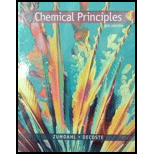
Concept explainers
(a)
Interpretation: The equilibrium picture of 10 molecules of HA and HCl acid in their two separate aqueous solutions needs to be drawn.
Concept Introduction: An acid is the substance that gives H+ or
On the contrary, a weak acid ionized partially and reaches to equilibrium.
(a)
Answer to Problem 6DQ
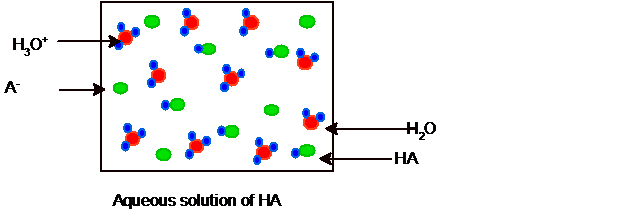
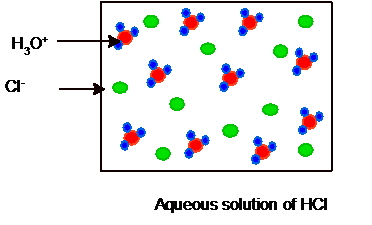
Explanation of Solution
HA is weak acid and HCl is a strong acid. For a weak acid HA, the ionization reaction can be written as:
Since it is partial ionization hence some molecules of HCl and water must be present in the solution and the picture of equilibrium can be shown as:
 Whereas HCl is a strong acid so it will ionize completely as given below. Hence no HCl and water molecules must be present in the solution.
Whereas HCl is a strong acid so it will ionize completely as given below. Hence no HCl and water molecules must be present in the solution.
Hence the picture of equilibrium can be shown as:
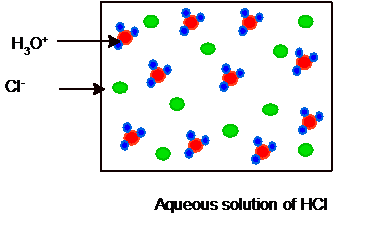
(b)
Interpretation: The major species in the two separate aqueous solution of HA and HCl acid needs to be determined.
Concept Introduction: An acid is the substance that gives H+ or
On the contrary, a weak acid ionized partially and reaches to equilibrium.
(b)
Answer to Problem 6DQ
Explanation of Solution
HA is weak acid and HCl is a strong acid. For a weak acid HA, the ionization reaction can be written as:
Whereas HCl is a strong acid so it will ionize completely as given below:
Hence the major species in both acids must be:
(c)
Interpretation: The Ka value from the equilibrium picture of 10 molecules of HA and HCl acid in their two separate aqueous solution needs to be calculated.
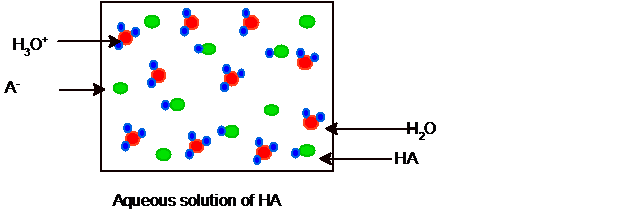
 Concept Introduction: An acid is the substance that gives H+ or
Concept Introduction: An acid is the substance that gives H+ or
On the contrary, a weak acid ionized partially and reaches to equilibrium.
(c)
Answer to Problem 6DQ
Explanation of Solution
The Kaexpression for both acids can be written as given :
Substitute the values of number of molecules from each picture:
(d)
Interpretation: The order from strongest to weakest base for
Concept Introduction: An acid is the substance that gives H+ or
On the contrary, a weak acid ionized partially and reaches to equilibrium.
(d)
Answer to Problem 6DQ
Explanation of Solution
HA is weak acid and HCl is a strong acid. For a weak acid HA, the ionization reaction can be written as:
Whereas HCl is a strong acid so it will ionize completely as given below:
According to the Bronsted-Lowery acid-base theory, a strong acid gives H+ ions and form weak conjugate base whereas a strong base accepts H+ ion to form weak conjugate acid of it. Since HA is weak acid and forms
Want to see more full solutions like this?
Chapter 7 Solutions
CHEM.PRINC.W/OWL2+REBATE+2 SUPPL.>IP<
- How is acid strength related to the value of Ka? What is the difference between strong acids and weak acids (see Table 13-1)? As the strength of an acid increases, what happens to the strength of the conjugate base? How is base strength related to the value of Kb? As the strength of a base increases, what happens to the strength of the conjugate acid?arrow_forwardThe following illustration displays the relative number of species when an acid, HA, is added to water. a. Is HA a weak or strong acid? How can you tell? b. Using the relative numbers given in the illustration, determine the value for Ka and the percent dissociation of the acid. Assume the initial acid concentration is 0.20 M.arrow_forwardEach box represents an acid solution at equilibrium. Squares represent H+ ions. Circles represent anions. (Although the anions have different identities in each figure, they are all represented as circles.) Water molecules are not shown. Assume that all solutions have the same volume. (a) Which figure represents the strongest acid? (b) Which figure represents the acid with the smallest Ka? (c) Which figure represents the acid with the lowest pH?arrow_forward
- Consider the following mathematical expressions. a. [H+] = [HA]0 b. [H+] = (Ka [HA]0)1/2 c. [OH] = 2[B]0 d. [OH] = (Kb [B]0)1/2 For each expression, give three solutions where the mathematical expression would give a good approximation for the [H+] or [OH]. [HA]0 and [B]0 represent initial concentrations of an acid or a base.arrow_forward. The concepts of acid-base equilibria were developed in this chapter for aqueous solutions (in aqueous solutions, water is the solvent and is intimately involved in the equilibria). However, the Brønsted-Lowry acid-base theory can be extended easily to other solvents. One such solvent that has been investigated in depth is liquid ammonia. NH3. a. Write a chemical equation indicating how HCl behaves as an acid in liquid ammonia. b. Write a chemical equation indicating how OH- behaves as a base in liquid ammonia.arrow_forwardUse Table 14.3 to help answer the following questions. a. Which is the stronger base, ClO4 or C6H5NH2? b. Which is the stronger base, H2O or C6H5NH2? c. Which is the stronger base, OH or C6H5NH2? d. Which is the stronger base, C6H5NH2 or CH3NH2?arrow_forward
- Tartaric acid is a weak diprotic fruit acid with Ka1 = 1.0 103 and Ka2 = 4.6 105. a Letting the symbol H2A represent tartaric acid, write the chemical equations that represent Ka1 and Ka2. Write the chemical equation that represents Ka1 Ka2. b Qualitatively describe the relative concentrations of H2A, HA, A2, and H3O+ in a solution that is about 0.5 M in tartaric acid. c Calculate the pH of a 0 0250 M tartaric acid solution and the equilibrium concentration of [H2A]. d What is the A2 concentration in solutions b and c?arrow_forwardFor conjugate acidbase pairs, how are Ka and Kb related? Consider the reaction of acetic acid in water CH3CO2H(aq)+H2O(l)CH3CO2(aq)+H3O+(aq) where Ka = 1.8 105 a. Which two bases are competing for the proton? b. Which is the stronger base? c. In light of your answer to part b. why do we classify the acetate ion (CH3CO2) as a weak base? Use an appropriate reaction to justify your answer. In general, as base strength increases, conjugate acid strength decreases. Explain why the conjugate acid of the weak base NH3 is a weak acid. To summarize, the conjugate base of a weak acid is a weak base and the conjugate acid of a weak base is a weak acid (weak gives you weak). Assuming Ka for a monoprotic strong acid is 1 106, calculate Kb for the conjugate base of this strong acid. Why do conjugate bases of strong acids have no basic properties in water? List the conjugate bases of the six common strong acids. To tie it all together, some instructors have students think of Li+, K+, Rb+, Cs+, Ca2+, Sr2+, and Ba2+ as the conjugate acids of the strong bases LiOH, KOH. RbOH, CsOH, Ca(OH)2, Sr(OH)2, and Ba(OH)2. Although not technically correct, the conjugate acid strength of these cations is similar to the conjugate base strength of the strong acids. That is, these cations have no acidic properties in water; similarly, the conjugate bases of strong acids have no basic properties (strong gives you worthless). Fill in the blanks with the correct response. The conjugate base of a weak acid is a_____base. The conjugate acid of a weak base is a_____acid. The conjugate base of a strong acid is a_____base. The conjugate acid of a strong base is a_____ acid. (Hint: Weak gives you weak and strong gives you worthless.)arrow_forwardUse Table 13-3 to help answer the following questions. a. Which is the stronger base, ClO4 or C6H5NH2? b. Which is the stronger base, H2O or C6H5NH2? c. Which is the stronger base, OH or C6H5NH2? d. Which is the stronger base, C6H5NH2 or CH3NH2?arrow_forward
- Explain why a sample of pure water at 40 C is neutral even though [H3O+]=1.7107M . Kw is 2.91014 at 40 C.arrow_forwardFrom the equilibrium concentrations given, calculate Ka for each of the weak acids and Kb for each of the weak bases.. (a). NH3:[OH]=3.1103M;[NH4+]=3.1103M;[NH3]=0.533M; (b). HNO2:[H3O+]=0.011M;[NO2]=0.0438M;[HNO2]=1.07M; (c). ( CH3)3N:[( CH 3 )3N]=0.25M;[( CH 3 )3NH+]=4.3103M;[OH]=4.3103M; (d). NH4+:[NH4+]=0.100M;[NH3]=7.5106M;[H3O+]=7.3106Marrow_forwardIonization of the first proton from H2SO4 is complete (H2SO4 is a strong acid); the acid-ionization constant for the second proton is 1.1 102. a What would be the approximate hydronium-ion concentration in 0.100 M H2SO4 if ionization of the second proton were ignored? b The ionization of the second proton must be considered for a more exact answer, however. Calculate the hydronium-ion concentration in 0.100 M H2SO4, accounting for the ionization of both protons.arrow_forward
 Chemistry: An Atoms First ApproachChemistryISBN:9781305079243Author:Steven S. Zumdahl, Susan A. ZumdahlPublisher:Cengage Learning
Chemistry: An Atoms First ApproachChemistryISBN:9781305079243Author:Steven S. Zumdahl, Susan A. ZumdahlPublisher:Cengage Learning ChemistryChemistryISBN:9781305957404Author:Steven S. Zumdahl, Susan A. Zumdahl, Donald J. DeCostePublisher:Cengage Learning
ChemistryChemistryISBN:9781305957404Author:Steven S. Zumdahl, Susan A. Zumdahl, Donald J. DeCostePublisher:Cengage Learning
 Chemistry: The Molecular ScienceChemistryISBN:9781285199047Author:John W. Moore, Conrad L. StanitskiPublisher:Cengage Learning
Chemistry: The Molecular ScienceChemistryISBN:9781285199047Author:John W. Moore, Conrad L. StanitskiPublisher:Cengage Learning Chemistry & Chemical ReactivityChemistryISBN:9781133949640Author:John C. Kotz, Paul M. Treichel, John Townsend, David TreichelPublisher:Cengage Learning
Chemistry & Chemical ReactivityChemistryISBN:9781133949640Author:John C. Kotz, Paul M. Treichel, John Townsend, David TreichelPublisher:Cengage Learning Chemistry & Chemical ReactivityChemistryISBN:9781337399074Author:John C. Kotz, Paul M. Treichel, John Townsend, David TreichelPublisher:Cengage Learning
Chemistry & Chemical ReactivityChemistryISBN:9781337399074Author:John C. Kotz, Paul M. Treichel, John Townsend, David TreichelPublisher:Cengage Learning





